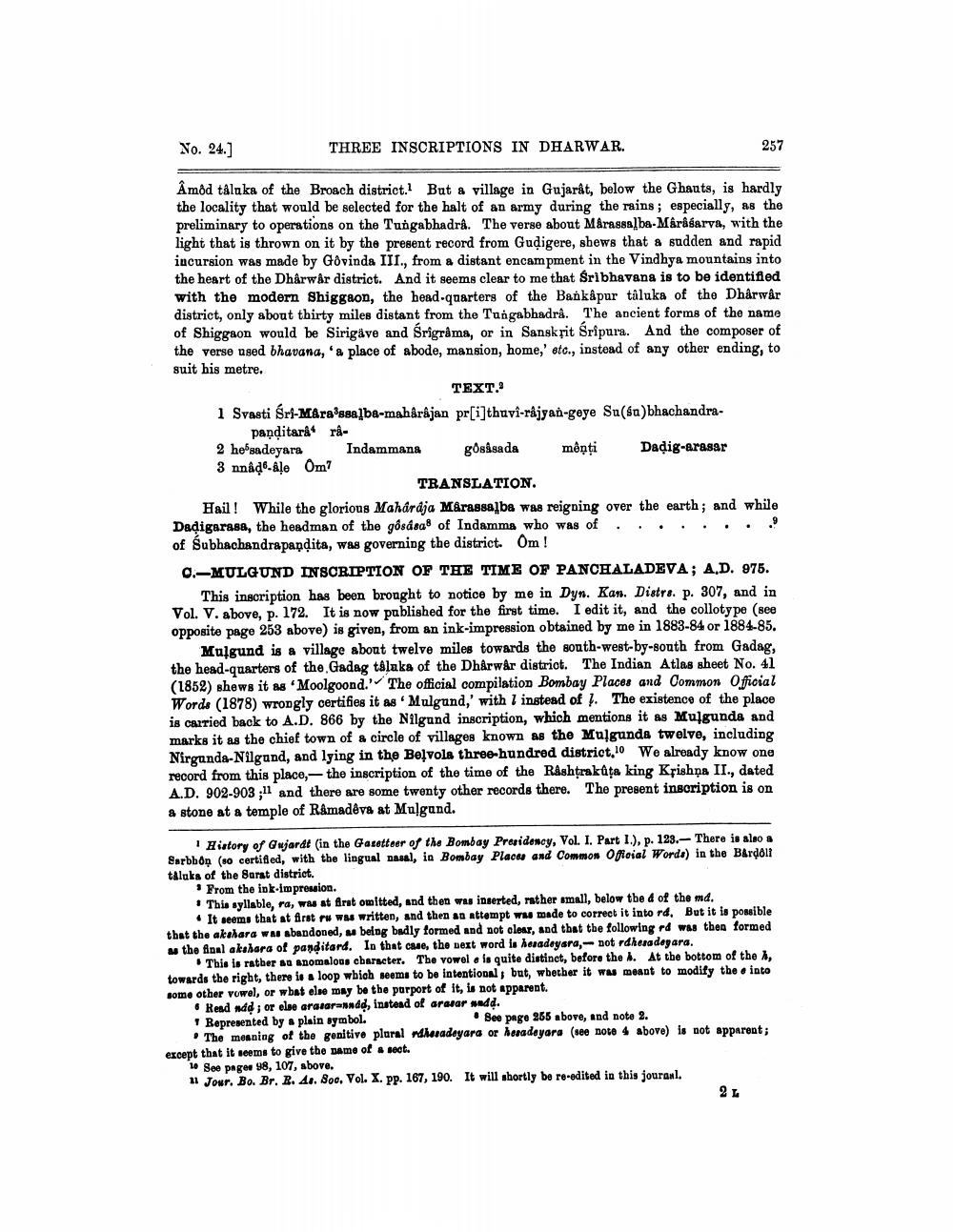________________
No. 24.]
THREE INSCRIPTIONS IN DHARWAR.
Âmôd taluka of the Broach district. But a village in Gujarât, below the Ghauts, is hardly the locality that would be selected for the halt of an army during the rains; especially, as the preliminary to operations on the Tungabhadra. The verse about Mârassalba-Mârâsarva, with the light that is thrown on it by the present record from Gudigere, shews that a sudden and rapid incursion was made by Govinda III., from a distant encampment in the Vindhya mountains into the heart of the Dhârwâr district. And it seems clear to me that Sribhavana is to be identified with the modern Shiggaon, the head-quarters of the Bankâpur tâluka of the Dharwâr district, only about thirty miles distant from the Tungabhadrâ. The ancient forms of the name of Shiggaon would be Sirigave and Śrigrama, or in Sanskrit Sripura. And the composer of the verse used bhavana, 'a place of abode, mansion, home,' etc., instead of any other ending, to
suit his metre.
TEXT.?
1 Svasti Śri-Mara3ssalba-mahârâjan pr[i]thuvi-rajyan-geye Su(su)bhachandra
panditarâ râ
Dadig-arasar
2 he'sadeyara 3 nnâde-âle Om7
Indammana
gosisada mêņți
257
TRANSLATION.
Hail! While the glorious Maharaja Marassalba was reigning over the earth; and while Daḍigarasa, the headman of the gosdeas of Indamma who was of of Subhachandrapandita, was governing the district. Om!
C.-MULGUND INSCRIPTION OF THE TIME OF PANCHALADEVA; A.D. 975.
This inscription has been brought to notice by me in Dyn. Kan. Distrs. p. 307, and in Vol. V. above, p. 172. It is now published for the first time. I edit it, and the collotype (see opposite page 253 above) is given, from an ink-impression obtained by me in 1883-84 or 1884-85. Mulgund is a village about twelve miles towards the south-west-by-south from Gadag, the head-quarters of the Gadag talaka of the Dharwâr district. The Indian Atlas sheet No. 41 (1852) shews it as 'Moolgoond. The official compilation Bombay Places and Common Official Words (1878) wrongly certifies it as 'Mulgund,' with 1 instead of 7. The existence of the place is carried back to A.D. 866 by the Nilgund inscription, which mentions it as Mulgunda and marks it as the chief town of a circle of villages known as the Mulgunda twelve, including Nirgunda-Nilgund, and lying in the Belvola three-hundred district,10 We already know one record from this place, the inscription of the time of the Rashtrakuta king Krishna II., dated A.D. 902-903;11 and there are some twenty other records there. The present inscription is on a stone at a temple of Ramadêva at Mulgund.
1 History of Gujarat (in the Gazetteer of the Bombay Presidency, Vol. I. Part I.), p. 123. There is also a Sarbbon (so certified, with the lingual nasal, in Bombay Places and Common Oficial Words) in the Bardoli taluks of the Surat district.
From the ink-impression.
This syllable, ra, was at first omitted, and then was inserted, rather small, below the d of the md.
It seems that at first ru was written, and then an attempt was made to correct it into rd. But it is possible that the akshara was abandoned, as being badly formed and not clear, and that the following rd was then formed as the final akshara of panditard. In that case, the next word is hesadeyara,- not rdhesadegara.
This is rather an anomalous character. The vowel e is quite distinct, before the A. At the bottom of the A, towards the right, there is a loop which seems to be intentional; but, whether it was meant to modify the e into some other vowel, or what else may be the purport of it, is not apparent.
Read ndd; or else arasar-nndd, instead of arasar nndd.
1 Represented by a plain symbol.
See page 255 above, and note 2.
The meaning of the genitive plural rdhesadeyara or headeyara (see note 4 above) is not apparent; except that it seems to give the name of a sect.
10 See pages 98, 107, above.
11 Jour. Bo. Br. R. As. Soc. Vol. X. pp. 167, 190. It will shortly be re-edited in this journal.
2 L




